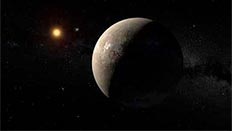Life around binary stars
What are binary stars?
Binary stars are two stars orbiting their common centre of mass. It is thought that over 50% of all stars within the universe may exist in binary or multiple star systems. Due to their abundance, it is important to determine whether life can exist around such stars. To answer this question we must first determine whether planets can ever form in these situations.
Initially, astronomers believed that the gravitational disruption caused by such a system would prevent planets from being able to form. However, we now know this is not the case. Scientists have now discovered many planets orbiting within binary star systems. These orbits can involve the planet orbiting either one (S-type) or both (P-type) of these stars. The possibility of a planet existing that is similar to Luke Skywalker's home planet, Tatooine, is far from science fiction!
Model these scenarios yourself
The maths involved with binary orbits is admittedly more complicated that that of a planet orbiting a single star. However, simulations do exist that allow you to easily model a planet orbiting within a binary system. Using the simulation provided below, use trial and error to first discover stable orbits - ones where the planet does not crash into the star or shoot off into empty space! Once you have a stable orbit you can then alter your parameter values so that the planet orbits with the habitable zone i.e. its temperature remains between 273K and 373K (0oC and 100oC).
- Binary simulator (XLS - 0.16 Mb) - this Excel based simulator allows you to visualise the path of a planet orbiting in a binary star system. The temperature of the planet is calculated and plotted throughout the duration of the orbit, allowing you to determine whether water can permanently exist in liquid form on its surface.
- Binary simulator guide (PDF - 0.11 Mb) - this guide is designed to be understood at university level, so do not worry if it seems confusing! It contains some of the maths background surrounding the subject, as well as describing certain aspects of the simulator.
Further details and example values providing stable orbits are provided in our guide (PDF - 2.2 Mb).

